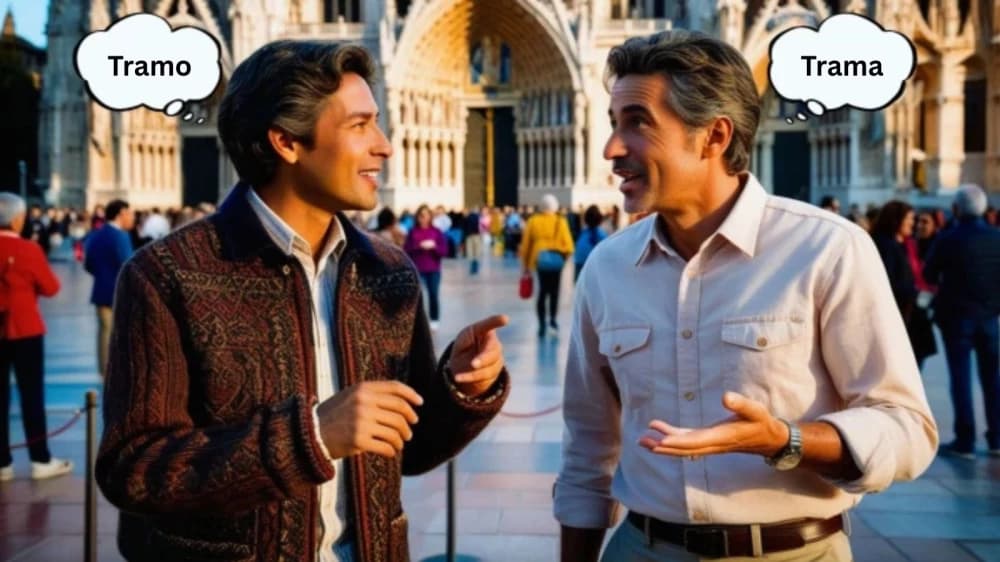From road sections to conspiracies and woven threads — discover how just one letter shifts the meaning entirely in Spanish.
This week’s Spanish word spotlight shines on another pair of near-twins that can confuse learners but carry quite distinct meanings: tramo (masculine) and trama (feminine). Though separated by just a single vowel, these two nouns occupy very different spaces in both language and life — one rooted in structure and stages, the other in fabric and fiction.
Tramo (Masculine): Stretching Through Space and Time
The word tramo is practical, grounded, and often refers to a linear segment or portion of something — a road, a river, a staircase, or even time itself.
1. A Physical Section or Stretch
This is one of the most common uses of tramo — to describe a part of something long or continuous:
-
este nuevo tramo de la carretera N-121 Pamplona-Behobia
(this new stretch of the N-121 road between Pamplona and Behobia) -
un tramo de la línea férrea que une la ciudad de México con el puente de Veracruz
(a section of the railway connecting Mexico City with the Veracruz bridge) -
Hay que tener mucho cuidado al cruzar este tramo de río.
(You have to be very careful when crossing this stretch of river.) -
La escalada me parecía más difícil que el tramo del primer día.
(The climb seemed harder than the first day’s segment.) -
el primer tramo de la novela
(the first part of the novel)
2. A Section of a Staircase
In architectural terms, un tramo can also be a flight of stairs, the part between two landings:
-
Bajó corriendo los dos tramos de escalera.
(She ran down the two flights of stairs.)
3. A Stage or Phase in a Process
Tramo also stretches into time-based processes, where it refers to a phase, part, or period:
-
en el tramo final del partido
(in the final stage of the match) -
Este proyecto está dividido en cuatro tramos de ejecución.
(This project is divided into four stages of execution.)
4. Tranches in Finance
In financial contexts, tramo takes on the meaning of a tranche — a portion of money or payments:
-
La deuda se liquidará en dos tramos.
(The debt will be settled in two tranches.)
Trama (Feminine): From Weaving to Plotting
In contrast to tramo’s structural practicality, trama is far more metaphorical and creative — weaving together ideas, fabric, and sometimes even conspiracies.
1. The Threads of Weaving
In textiles, la trama is the weft — the threads woven across the width of the fabric — in contrast to la urdimbre, the warp, which runs lengthwise:
-
la trama y la urdimbre del tapiz
(the weft and warp of the tapestry) -
un tejido de algodón con trama abierta
(a loosely woven cotton fabric)
2. The Fabric of a Story: Plot
In storytelling, trama translates directly to plot — the sequence and structure of a story’s events:
-
la enredada trama de una novela
(the tangled plot of a novel) -
La trama de la novela gira en torno a unos jóvenes que deciden robar un cuadro.
(The plot revolves around a group of young people planning to steal a painting.)
3. Secret Plots and Schemes
But not all tramas are literary. The word can also mean a secret or sinister plan, often involving deception or harm:
-
Pude reconstruir toda la trama de lo que resultó ser una verdadera conspiración para matar al General.
(I was able to reconstruct the entire plot, which turned out to be a real conspiracy to kill the General.)
BONUS: The Verb Tramar
The verb tramar comes from the same root as trama and carries similar shades of meaning. While it can mean "to weave," it’s more commonly used to mean to plan, hatch, or plot, especially in secret:
-
Deciden tramar su escape.
(They decide to plan their escape.) -
Se trama una conspiración.
(A conspiracy is being plotted.) -
Detuvieron a otras tres personas sospechosas de tramar un atentado contra la presidenta.
(Three more people were arrested, suspected of plotting an attack on the president.) -
Algo deben de estar tramando.
(They must be up to something.)
Conclusion: One Letter, Two Worlds
Despite their similar spellings, tramo and trama take you down entirely different paths — one through linear space and timed stages, the other through woven threads and mysterious schemes. Mastering the difference isn’t just about vocabulary; it’s about understanding how Spanish words evolve and resonate across different contexts.







